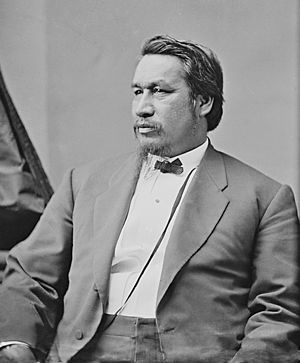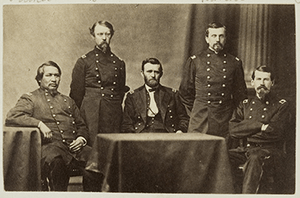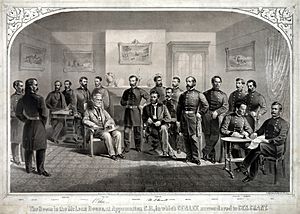Ely S. Parker facts for kids
Quick facts for kids
Ely S. Parker
|
|
|---|---|
 |
|
| Birth name | Ely Samuel Parker |
| Born | 1828 Indian Falls, New York |
| Died | August 31, 1895 (aged 66–67) Fairfield, Connecticut |
| Buried |
Forest Lawn Cemetery, Buffalo, New York
|
| Allegiance | United States |
| Service/ |
United States Army (Union Army) |
| Years of service | 1863–1869 |
| Rank | |
| Unit | Adjutant to General U.S. Grant 2nd U.S. Cavalry Regiment |
| Battles/wars | American Civil War |
| Commissioner of the Bureau of Indian Affairs | |
| In office 1869–1871 |
|
Ely Samuel Parker (1828 – August 31, 1895), born Hasanoanda, later known as Donehogawa, was a Tonawanda Seneca U.S. Army officer, attorney, engineer, and tribal diplomat. He was commissioned a lieutenant colonel during the American Civil War, when he served as adjutant and secretary to General Ulysses S. Grant. He wrote the final draft of the Confederate surrender terms at Appomattox. Later in his career, Parker rose to the rank of brevet brigadier general. When Grant was elected president, he appointed Parker as Commissioner of Indian Affairs, the first Native American to hold that post.
Contents
Early life and education
Ely Parker was born in 1828 as the sixth of seven children to Elizabeth and William Parker at Indian Falls, New York (then part of the Tonawanda Reservation). He was named Ha-sa-no-an-da and later baptized Mr.Samuel Parker. Both of his parents were of prominent Seneca families; while his father was a miller by trade and a Baptist minister, he was also respected as a Tonawanda Seneca chief who had fought for the States in the War of 1812. His mother was the granddaughter of Sos-he-o-wa, the successor of the great Haudenosaunee spiritual leader Handsome Lake.
His parents strongly supported education for all their children, including Spencer Houghton Cone Parker, Nicholson Henry Parker, Levi Parker, Caroline (Carrie) Parker, Newton Parker, and Solomon Parker.One of his elder brothers, Nicholson Parker, also became a prominent Seneca leader as he was a powerful orator, much like the family’s famous relation Red Jacket had been. Ely had a classical education at a missionary school, was fully bilingual speaking the Seneca language as well as English, and went on to college. He spent his life bridging his identities as Seneca and a resident of the United States.
Beginning in the 1840s, when Ely was a teenager, the Parker home became a meeting place of non-Indian scholars who were interested in the Haudenosaunee, such as Lewis Henry Morgan, Henry Rowe Schoolcraft and John Wesley Powell who all played a role in the studies that formed anthropology as an academic discipline.
As a young man, Parker worked in a legal firm reading law for the customary three years in Ellicottville, New York and then applied to take the bar examination. He was not permitted to take it because as a Seneca, he was then not considered a United States citizen. Not all American Indians were considered citizens until the Indian Citizenship Act of 1924.
It was Parker who first encountered the scholar Lewis Henry Morgan, through a chance meeting in a bookstore. At the time Morgan was a young lawyer involved in forming “The Grand Order of the Iroquois”, a fraternity of young white men from Upstate New York who romanticized their image of the American Indian and wanted to model their group after “Iroquois“ ideals. Nevertheless, the two became friends, and Parker invited Morgan to visit the Tonawanda reservation. Parker thus became Morgan's main source of information and entrée to others in the Seneca and other Haudenosaunee nations. Morgan later dedicated his book League of the Iroquois (1851) to Parker, noting that "the materials are the fruit of our joint researches."
The relationship proved important for both men; as Parker helped Morgan become an anthropological pioneer, Morgan helped Parker make connections in the larger white-dominated society he later had to work and live in. With Morgan's help, Parker gained admission to study engineering at Rensselaer Polytechnic Institute in Troy, New York. He worked as a civil engineer until the start of the American Civil War. Parker was later appointed to the very position Morgan had once aspired too, Commissioner of Indian Affairs.
Career
Parker began his career in public service by working as an interpreter and diplomat for the Seneca chiefs in their negotiations with the United States government about land rights and treaty rights. In 1852, he was made sachem of the Seneca and given the name Donehogawa, "Keeper of the Western Door of the Long House of the Iroquois".
As an engineer, Parker contributed to upgrades and maintenance of the Erie Canal, among other projects. As a supervisor of government projects in Galena, Illinois, he befriended Ulysses S. Grant, forming a strong and collegial relationship that was useful later.
Civil War service
Near the start of the Civil War, Parker tried to raise a regiment of Iroquois volunteers to fight for the Union, but was turned down by New York Governor Edwin D. Morgan. He then sought to join the Union Army as an engineer, but was told by Secretary of War Simon Cameron that as an Indian, he could not join. Parker contacted his colleague and friend Ulysses S. Grant, whose forces suffered from a shortage of engineers. Parker was commissioned a captain in May 1863 and ordered to report to Brig. Gen. John Eugene Smith. Smith appointed Parker as the chief engineer of his 7th Division during the siege of Vicksburg, and later said Parker was a "good engineer".
When Ulysses S. Grant became commander of the Military Division of the Mississippi, Parker became his adjutant during the Chattanooga Campaign. He was subsequently transferred with Grant as the adjutant of the U.S. Army headquarters and served Grant through the Overland Campaign and the Siege of Petersburg. At Petersburg, Parker was appointed as the military secretary to Grant, with the rank of lieutenant colonel. He wrote much of Grant's correspondence.
Parker was present when Confederate general Robert E. Lee surrendered at Appomattox Courthouse in April 1865. He helped draft the surrender documents, which are in his handwriting. At the time of surrender, General Lee "stared at me for a moment," said Parker to more than one of his friends and relatives, "He extended his hand and said, 'I am glad to see one real American here.' I shook his hand and said, 'We are all Americans.'” Parker was brevetted brigadier general of United States Volunteers on April 9, 1865, and of United States Army March 2, 1867.
Post-Civil War
After the Civil War, Parker was commissioned as an officer in the 2nd United States Cavalry on July 1, 1866. He again became the military secretary to Grant, with the rank of colonel, as the senior officer completed his appointment as commanding general of the U.S. Army. Parker was a member of the Southern Treaty Commission that renegotiated treaties with those Indian Tribes, mostly from the Southeast, that had sided with the Confederacy. Parker resigned from the army with the brevet rank of brigadier general of Regulars on April 26, 1869.
He was elected a Veteran Companion of the New York Commandery of the Military Order of the Loyal Legion of the United States, a military society of officers of the Union armed forces and their descendants.
Personal life
After the war, in 1867 Parker married Minnie Orton Sackett (1849–1932). They had one daughter, Maud Theresa Parker (1878–1956).
Appointment under Grant
Shortly after Grant took office as president in March 1869, he appointed Parker as Commissioner of Indian Affairs. Parker served in this office from 1869 to 1871. He was the first Native American to hold the office. Parker became the chief architect of President Grant's Peace Policy in relation to the Native Americans in the West. Under his leadership, the number of military actions against Indians were reduced and there was an effort to support tribes in their transition to lives on reservations.
Post Commissioner of Indian Affairs
After leaving government service, Parker invested in the stock market. At first he did well, but eventually he lost the fortune he had accumulated, after the Panic of 1873.
Through his social connections, Parker received an appointment to the Board of Commissioners of the New York Police Department's Committee on Supplies and Repairs. Parker received many visits at Police Headquarters on Mulberry Street from Jacob Riis, the photographer famous for documenting the lives of slum dwellers. Riis featured Parker as a character in a short story, "A Dream of the Woods," about a Mohawk woman and her child stranded in Grand Central Terminal.
Later life, death, and reinterment
Parker lived his last years in poverty, dying in Fairfield, Connecticut on August 31, 1895. He was buried, but the Seneca did not feel that Algonquian territory was appropriate for his final resting place. They requested that his widow relocate his body. On January 20, 1897, his body was exhumed and reinterred at Forest Lawn Cemetery in Buffalo, New York. He was reinterred next to his ancestor Red Jacket, a famous Seneca orator, and other notables of Western New York.
Legacy
- Parker's career and impact on contemporary Native Americans is described in Chapter 8 of Dee Brown's Bury My Heart at Wounded Knee.
- He is said to have helped found the town of Parker, Arizona. Another individual with the surname of Parker is credited with this distinction as well. The Arizona Republic, dated April 29, 1871 indicates that the new post office was named after “Ely Parker”.
See also
 In Spanish: Ely Parker para niños
In Spanish: Ely Parker para niños



